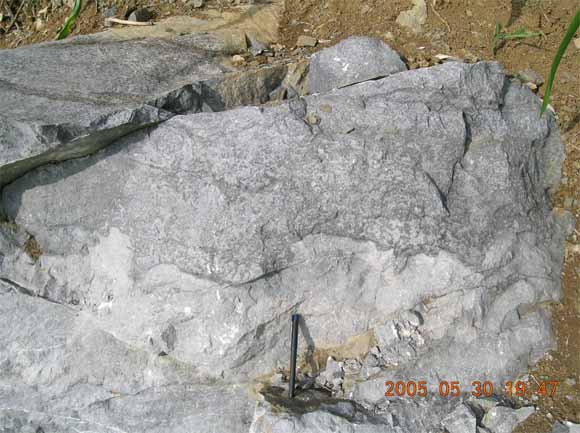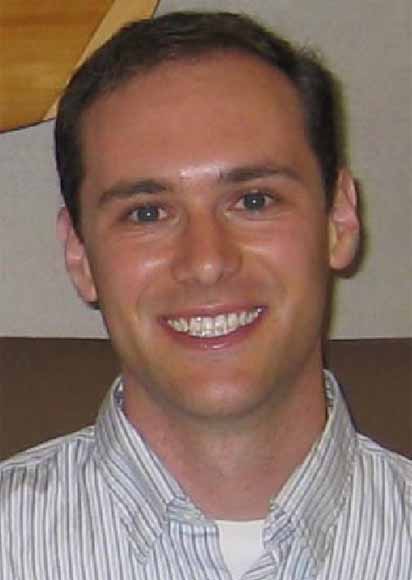
Location: Stanford University
see Map showing Mitchell and GeoCorner Room 320
This will be the 374th meeting since 1954

The Permian-Triassic boundary on the Great Bank of Guizhou in Guizhou Province, China. This photo illustrates the contact between underlying fossiliferous Upper Permian platform carbonates and overlying poorly fossiliferous microbial mound (dark) deposited in the immediate aftermath of extinction.
The extinction pulse at the end of the Permian Period was the most severe since the origin of animal life (~90% species extinction). Extinction was (geologically) rapid, global, and affected both marine and terrestrial organisms and appears to have been associated with rapid global warming. Subsequent recovery appears to have been delayed by as much as 5 million years. Exposure of thick and relatively continuous Late Permian through Late Triassic stratigraphic sections on an isolated carbonate platform in southern China provides the opportunity to link paleontological and biogeochemical data from a single field site through the most dramatic period of biological change in the Phanerozoic.
Observations of recovery on a shallow carbonate platform in southern China reveal that the five million years of the Early Triassic are characterized by instability of the global carbon cycle, low abundance and small size of skeletal benthic invertebrates, and patterns of calcium carbonate deposition more characteristic of the Proterozoic. The long delay of recovery and persistent carbon cycle instability suggest the end-Permian extinction resulted from terrestrial rather than extraterrestrial causes, and that the style of disturbance associated with rapid extinction persisted, at least intermittently, through the Early Triassic. The exact geological trigger of the event remains poorly understood, but coupled paleontological and biogeochemical datasets provide new constraints on possible extinction and recovery scenarios. The possibility that the extinction was associated with a pronounced and rapid rise in atmospheric pCO2 suggests that the Early Triassic may provide a glimpse of the type of world that could also lie in the near future.

Jonathan Payne
Reservations: The preferred way to make reservations is simply to email Janice Sellers at janicemsj@gmail.com by November 4, tell her you will attend, commit to pay, and bring your payment to the meeting. Janice always emails a confirmation; if you don't get one, assume email crashed yet again and email her a second time. A check made to "PGS" is preferred, payable at the meeting.
If you want to pay in advance:
Stanford faculty and students: Please make dinner reservations by November 4. Contact Dr. Elizabeth Miller via her mailbox (and leave check), Geological and Environmental Sciences Office, Geocorner - Bldg. 320 (Rm. 205). Make checks out to "PGS."
All others, including faculty and students from other Bay Area universities and colleges and USGS: Please make dinner reservations by November 4. Contact Janice Sellers, at 1066 28th Street, Oakland, CA 94608-4547, (510) 268-8254 . Send check made out to "PGS" to Janice.
Dinner is $30.00. Includes wine (5:30 to 6:15 PM.) and dinner (6:15-7:30 PM.).
For students from all universities and colleges, the dinner, including the social 3/4-hour, is $5.00 and is partially subsidized thanks to the School of Earth Sciences, Stanford University (Note, no-show reservations owe the full price).
Doris, whose wonderful crew prepares our meals, asked that we let you know that people who are late RSVP'ing and people who show up without a reservation will be welcome but that they will be eating on paper plates with plastic utensils (food supply permitting).
Dues for Academic Year 2005-2006 ($10.00) should be sent to Janice Sellers, 1066 28th Street, Oakland, CA 94608-4547. Janice's phone: (510) 268-8254.
Officers: Ray Wells, President; Dwight Harbaugh and Elizabeth Miller, Co-Vice Presidents; Mike Diggles, Secretary; Janice Sellers, Treasurer; Bob Coleman, Field-Trip Czar

Date created: October 14, 2005
Last modified: October 27, 2005
Created by: Mike Diggles, Vice President, PGS.